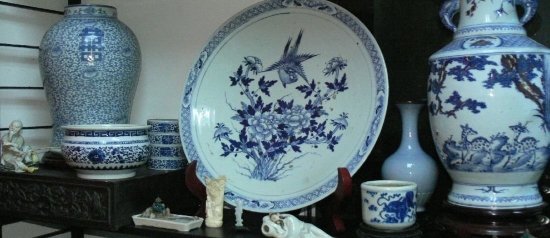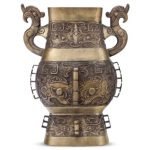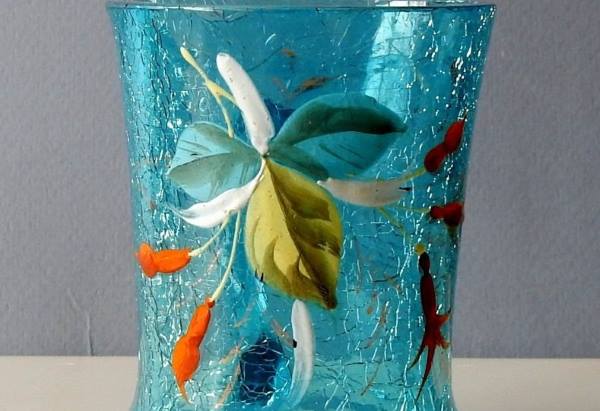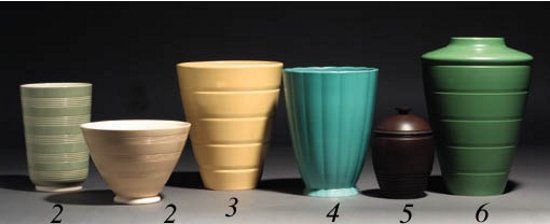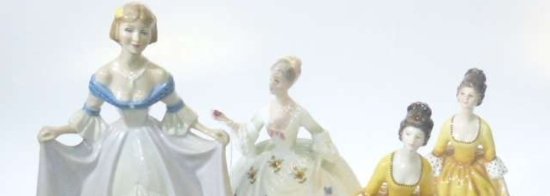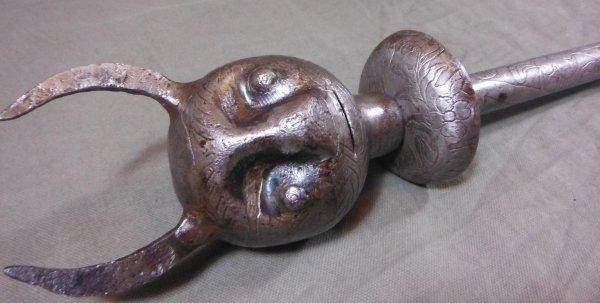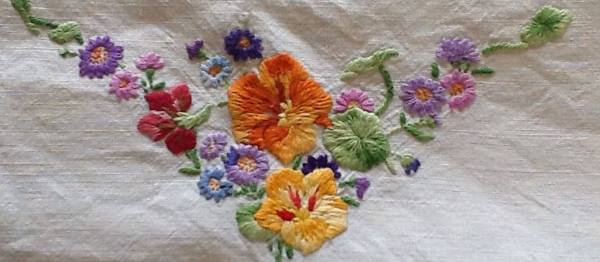What does Carlton Ware mean to you? Most think of the leaf shaped dishes with embossed tomatoes or flowers, for others it is Chinese style vases, or perhaps zany pots with attached feet from the 1970s.
Over the last decade we have seen an increasing interest in this factory’s output. A club was formed and Carlton Ware from all periods could be found at antiques fairs from specialist dealers. Even the auctioneers, Christie’s introduced an annual specialist Carlton Ware sale that resulted in Art Deco patterns reaching four figure sums never before realised.
As with many collectable items we are now seeing either a slowing down, or even a reduction in prices. This is not unusual in the collecting world; most notable potteries have done exactly the same on their way to further appreciation.
With the turn of the Century the early part of Carlton Ware’s pots have become antique. The company’s beginnings go back to 1890 when James F. Wiltshaw with James A. Robinson and William H. Robinson took over a factory in Copeland Street, Stoke on Trent, and began trading as Wiltshaw & Robinson. They manufactured earthenware in the latest styles using ground colours of white, vellum or blush (The latter two much in the style of the Royal Worcester blush ivory or peach bloom). The designs were typically floral and were transfer printed, infilled with hand colouring. The most elaborate and expensive designs were adorned with raised paste gilding giving a three-dimensional look.
From 1890 to 1894 Wiltshaw & Robinson used a back stamp that is known as the Ribbon mark, with no mention of the words Carlton Ware. By 1894 the back stamp was changed to the ‘Crown Mark’ with Carlton Ware printed below. This mark was used in many many different forms until the mid 1920s.
In 1902 Carlton Ware started manufacturing heraldic china and were to become one of the top three sellers of this type of ware along with Goss and Arcadian. Carlton Ware added their own distinctive style during the 1920s by using their new lustrous colours on the pieces.
By 1911 James Frederick became sole proprietor of the company. Horace Wain was employed as their in-house designer. New patterns and shapes were to emerge reflecting Wain’s great interest in Chinese ceramics such as the oriental designs on ground colours of powder blue or two-tone matt combinations in terracotta and black.
Stoke Railway Station was the scene of the accidental death of James Frederick Wiltshaw in 1918. At this time his son, Cuthbert, was away at war serving in the Royal Flying Corps and on his return he took over the reigns.
One of the first new styles to emerge under his leadership was the introduction of twelve lustrous colours (used on the previously mentioned Heraldic Ware). These colours were offered with or without a pattern on shapes that had previously been used for other designs.
The first part of the 1920s sees Horace Wain leaving Carlton Ware and being replaced by Enoch Boulton. This inter-war period was an exciting time for some, the finding of Tutankhamen’s tomb, the most complete Egyptian tomb to be excavated, and the advent of the Art Deco period bringing all the decadence of this age and giving an abundance of inspiration from all walks of life. Carlton Ware was not to be left behind.
Between 1925 & 1927 Carlton Ware changed their back stamp to what is known as the Script mark.
Enoch Boulton introduced further oriental inspired designs including the most sought after Chinaland pattern. He launched the designs for the Tutankhamen range and started producing what we can loosely interpret as the beginnings of the Art Deco patterns such as Landscape Tree, Paradise Bird and Tree and Cubist Butterfly.
More affordable everyday ware was also produced. Even today most people will have come across Salad Ware – yes, the lettuce leaf with bold red tomatoes strategically placed, suggesting warm summers spent in the garden. These ranges included Tomato & Lettuce and Lobster.
In the late 1920s Carlton Ware were to take over the bone china company Birks, Rawlins & Co. This allowed them to produce fine bone china tea, dessert and coffee wares. Production ceased in 1930 when the company was placed into administrative receivership. Cuthbert was not going to let the company fold and approximately two years later following strict economies throughout the factory, the board regained control. These economies meant that Enoch Boulton left Carlton Ware, which paved the way for several female artists, the first being Vi Elmer.
Miss Elmer’s extraordinary design skills were to produce the fantastic Art Deco patterns that are so sought after today. These include Jazz, Lightning, Red Devil, Rainbow Fans, Floral Comets, Fantasia, Fan, and Wagon Wheels etc.
During the 1930s freehand designs were popular. Carlton Ware’s answer was the ‘Handcraft’ range; the back stamp included the name along with the Script Mark. Although we tend to recognise this range as having a matt glaze there were examples offered in high glaze or a combination of both.
Novelties were produced in abundance and included napkin rings in the form of ladies, Punch, Judy, a Paperboy, Policeman and others. Small oval ashtrays with Bride and Bridegroom, or a rabbit were also offered.
Vi Elmer also expanded the embossed ware introducing such ranges as Oak Tree. She also extended the Salad Ware by launching more floral and fruit inspired designs such as Anemone in a bright yellow, green or mottled pink. The floral and fruit embossed items were available in a variety of colours and shapes, including cruets, beakers with covers and breakfast sets; a pretty and colourful display to add to any table. This ware had its own back stamp that included the script mark together with Trade Mark, Made in England, Registered Australian Design, Registration Applied For. This does not mean that the items were made in Australia; it means that the designs were registered there to stop the Japanese copying them.
Olive Kew joined Vi followed by Renee Pemberton. All contributed to the continued success of Carlton Ware. The Second World War curtailed production in the pottery industry. Wiltshaw & Robinson continued to produce wares but under the limitations imposed. These restrictions were not lifted until 1952. By then Vi and Olive had left the company and although Renee had also left to start a family she was asked to return in 1947. Whilst away experiments had been carried out on a new lustre range that was to become known as the Royales. These went into full production once restrictions were lifted with the most well known being Rouge Royale but there is also Bleu, Noir and Verte. Designs appearing were Crane & Willow and Spiders Web as well as others.
By the mid 1950s Renee had left and Chris Boulton was employed as their designer. Renee had continued with some of the floral embossed introducing Hydrangea and Poppy and Daisy. Chris introduced Poppy, Convolvulus and Magnolia and brought Carlton Ware into the New Age with further new ranges influenced by organic formed shapes and patterns.
We think of the Art Deco period as being the most inspirational but fantastic designs were to come from all quarters in the 1950s following the emergence from war time restrictions coupled with scientific discoveries including the splitting of the atom and the new nuclear wonder fuel. Carlton Ware’s contribution to this period really didn’t happen until the late 1950s with the introduction of patterns such as Windswept, perhaps the best known of the 50s patterns.
In 1958 Carlton Ware changed their name from Wiltshaw & Robinson to Carlton Ware Limited.
Another designer emerged from Carlton Ware, Philip Forster. He was to produce the Orbit pattern, an archetypal design and one for collectors to watch out for.
During the 1960s the Royale range continued with new patterns such as Kingfisher and Waterlily, Dragonfly and Waterlily and Vine, the oriental Mikado and New Mikado designs were still available. Novelties were now cruets in the form of animals, vegetables, fruit and shells. Advertising ware was high on the agenda, the most famous being the Guinness items in the form of flying toucans and the zoo series (most of those on the market today are counterfeit examples, so beware).
A turning point in the history of Carlton Ware occurred in 1966 when Cuthbert Wiltshaw died. Carlton Ware Limited was sold to Arthur Wood (Longport) Ltd and Anthony Wood was installed as Managing Director.
Mr Wood continued the Royale range and reintroduced old patterns using gilt lithographic prints and hand enamelling. New designs to emerge were Dragon and Cherry Blossom on fashionable coloured grounds.
The 1970s brings new shapes such as Oslo and Athena and new patterns such as Java or Denim. The bright colours of the 1970s were expressed through the moneybox or the bird series and even coffee sets had the odd colour combinations that are becoming so collectable today.
During this period Anthony Wood was to take on board the most inventive of all ranges, designed by Roger Michell and Danka Napiorkowsa of Lustre Pottery. This was the feet ware, which was available in four main ranges, the first being the Walking ware followed by RJS or Running, Jumping and Standing Still. The same shapes used for the RJS were available with the Caribbean design and finally the Big Feet range. These were not the only items to come from Lustre Pottery.
Carlton Ware still had their in-house designers such as Angela Fox and Pamela Souch who produced the moneyboxes, the Hovis and Alice in Wonderland ranges as well as many others.
In 1987 Carlton Ware was sold to County Potteries who went into receivership in 1989. The factory site was sold as an empty shell and the contents lotted and sold by tender. John McCluskey of Grosvenor Ceramics purchased the trade name, some moulds, shape, pattern books and goodwill, relaunching Carlton Ware in 1992 but ceased production two years later.
In March 1997 Mr. McCluskey sold the Trade Name to Frank Salmon. Mr. Salmon does not own a pottery but has his new Carlton Ware manufactured by others such as Bairstow Manor Pottery. Items include the Carlton Kids, Gollys and female figures such as Sunflower girl and Butterfly girl. There are also novelty teapots in the form of aeroplanes with different pilots, for example Elvis and Winston Churchill.


